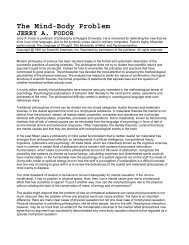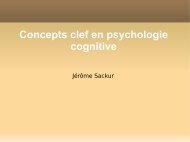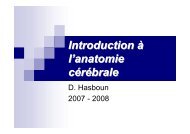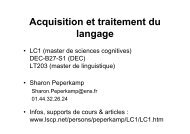From single to multiple deficit models of developmental disorders
From single to multiple deficit models of developmental disorders
From single to multiple deficit models of developmental disorders
Create successful ePaper yourself
Turn your PDF publications into a flip-book with our unique Google optimized e-Paper software.
394 B.F. Penning<strong>to</strong>n / Cognition 101 (2006) 385–413<br />
association is not limited <strong>to</strong> retrospective reports because young children selected for<br />
family risk for RD also have higher rates <strong>of</strong> preschool speech and language problems<br />
than controls (Gallagher, Frith, & Snowling, 2000; Lyytinen et al., 2002; Penning<strong>to</strong>n<br />
& LeXy, 2001; Scarborough, 1990). But these previous studies have rarely distinguished<br />
SSD from speciWc language impairment (SLI), which is deWned by deWcits in<br />
semantics and syntax. So, it is less clear which subtypes (or components) <strong>of</strong> SSD per<br />
se presage which kinds <strong>of</strong> later literacy problems.<br />
3.2.2. Cognitive and etiological overlap<br />
It is well known that the large majority <strong>of</strong> children with RD have deWcits on measures<br />
<strong>of</strong> phonological processing (Wagner & Torgesen, 1987), including measures <strong>of</strong><br />
both explicit (i.e., phoneme awareness) and implicit (i.e., phonological memory and<br />
rapid serial naming) phonological processing. There is also accumulating evidence<br />
that many children with speech and language problems have phonological processing<br />
problems, such as deWcits on measures <strong>of</strong> phoneme awareness and phonological<br />
memory (Bird & Bishop, 1992; Bird, Bishop, & Freeman, 1995; Bishop, North, &<br />
Donlan, 1995; Clarke-Klein & Hodson, 1995; Edwards & Lahey, 1998; Kamhi, Catts,<br />
Mauer, Apel, & Gentry, 1988; Leonard, 1982; Lewis & Freebairn, 1992; Montgomery,<br />
1995).<br />
Support for a shared etiology for SSD and RD has been provided by Lewis and<br />
colleagues (Lewis, 1990, 1992; Lewis, Ekelman, & Aram, 1989), who found that SSD<br />
and RD are co-familial, meaning that both <strong>disorders</strong> run in the same families. C<strong>of</strong>amiliality<br />
could be explained by either genetic or environmental risk fac<strong>to</strong>rs shared<br />
by family members, so Wnding co-familiality does not necessarily mean the two <strong>disorders</strong><br />
share genetic risk fac<strong>to</strong>rs (i.e., are co-heritable). Using a twin design, we have<br />
found that SSD and RD are co-heritable as well (Tunick & Penning<strong>to</strong>n, 2002).<br />
3.2.3. Hypotheses <strong>to</strong> explain SSD/RD comorbidity<br />
For a <strong>single</strong> cognitive deWcit theorist, the etiological and cognitive overlap<br />
between SSD and RD suggests the parsimonious severity hypothesis (cf. Harm &<br />
Seidenberg, 1999), which was discussed earlier. The severity hypothesis holds that<br />
many cases <strong>of</strong> SSD and RD lie on a severity continuum in which shared etiological<br />
risk fac<strong>to</strong>rs lead <strong>to</strong> a shared underlying phonological deWcit. In other words, SSD and<br />
RD are alternate forms <strong>of</strong> the same disorder. If the phonological deWcit is severe<br />
enough, it Wrst produces SSD and then later RD. If it is less severe, it does not produce<br />
diagnosable SSD (though it may lead <strong>to</strong> subclinical speech production problems),<br />
but it does produce later RD, because reading requires more mature<br />
phonological representations than does speech. So this hypothesis posits that RD<br />
without earlier SSD is a less severe variant <strong>of</strong> SSD. To account for the many children<br />
with SSD who do not develop later RD, the severity hypothesis must posit that they<br />
have a subtype <strong>of</strong> SSD that is caused by diVerent underlying cognitive deWcit. If they<br />
had the same underlying phonological deWcit as SSD children with later RD, and if<br />
this <strong>single</strong> deWcit were suYcient <strong>to</strong> produce RD as the severity hypothesis posits, then<br />
there would be a contradiction. Because phonology is complex, SSD children without<br />
later RD could conceivably have a diVerent kind <strong>of</strong> phonological deWcit than SSD







